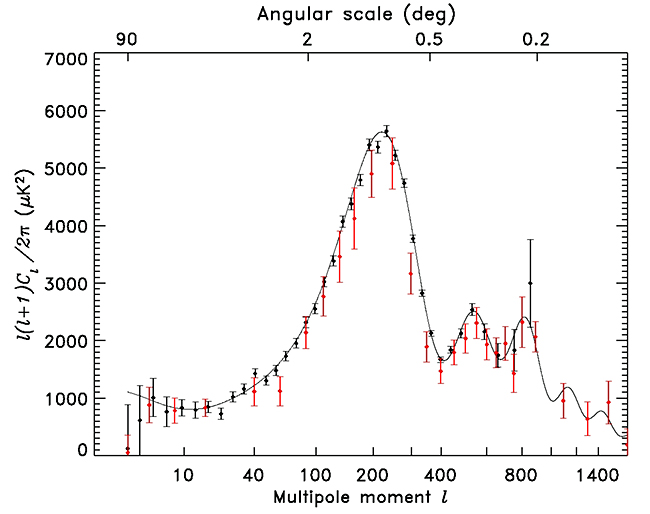Despite the much higher quality of the measurements
than any previously available, the 'concordance model universe'
still matches the data well.
The one significant change is that WMAP seems to detect much higher
polarization on very large angular scales (> 20o)
than expected.
This suggests that the first stars or quasars formed, and re-ionized
the Universe, much earlier than previously thought, at a redshift of about
z ![]() 17, only a few hundred million years after the Big Bang.
17, only a few hundred million years after the Big Bang.
The WMAP team got their most precise results by combining the WMAP data with other measurements of fluctuations on smaller scales: the ACBAR measurements of high-l CMB fluctuations, the 2DF Galaxy Redshift Survey for the present-day power spectrum of the large-scale structure, and data from the forest of hydrogen absorption lines found in the spectra of distant quasars, which measures fluctuations in the intergalactic gas on scales equivalent to l of several thousand. Together, these data provide remarkably tight constraints on the parameters of the Universe: for instance the age of the Universe is calculated to be 13.7±0.2 billion years (almost exactly three times the age of our Solar System). These numbers should be treated with a pinch of salt, since they rely on all the different experiments being correct within their quoted uncertainties, i.e. no systematic errors. There is tantalizing evidence that the initial spectrum of fluctuations produced by inflation (or whatever) is not a pure power law; if true this would, for the first time, allow us to go beyond the vague predictions of inflation as a scenario and begin to test some specific physical theories of how it happened.
Finally, the WMAP results confirm an earlier result from COBE, that there is surprisingly little structure in the CMB on the very largest scales, measured by the all-sky quadrupole (l = 2) and maybe octopole. This has prompted some fascinating speculation that we do indeed live in a topologically compact universe; but the smoking gun of identical circles on the sky has not (yet) been found.
